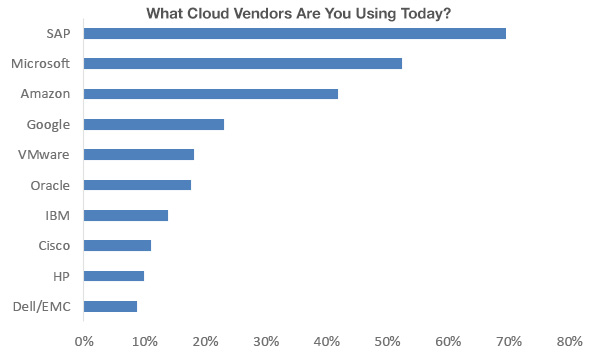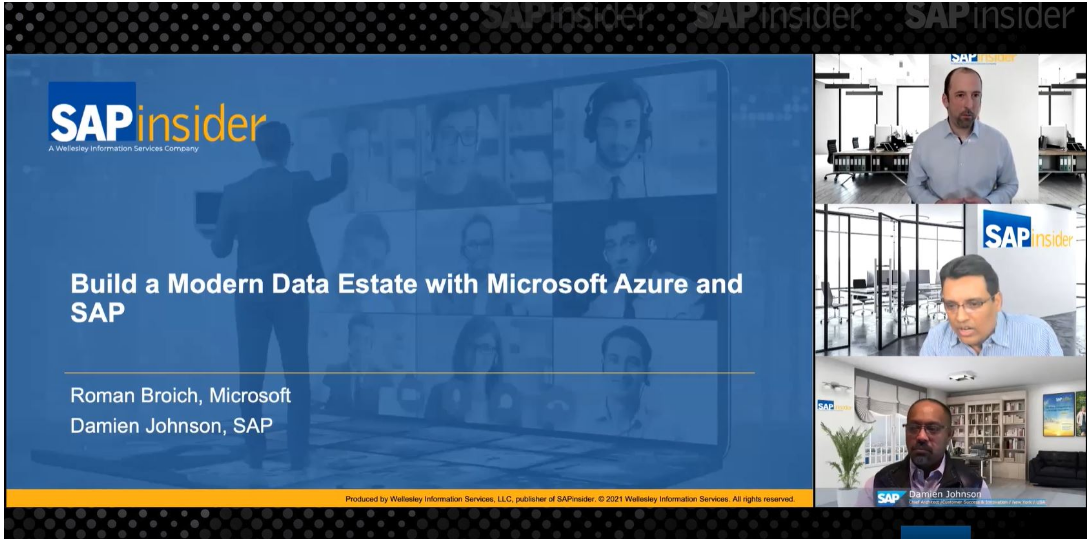SAP Announces Microsoft Azure as Key Cloud Platform for SAP S/4HANA
How the New Strategic Partnership Between SAP and Microsoft Affects SAPinsiders and Beyond
Today’s SAP Q3 2019 earnings call went way beyond announcing double-digit year over year revenue growth and a 37% boost in cloud revenue, as it also unveiled a new strategic partnership with Microsoft that emphasizes Microsoft Azure as the key cloud platform to support SAP S/4HANA, SAP’s flagship ERP release.
With the Microsoft Azure and SAP S/4HANA news, SAP has tilted the playing field toward Microsoft with what they’re calling the “Embrace” partnership.
During the SAP Q3 2019 earnings call, SAP outlined a go-to-market partnership that covers sales, marketing, industry-specific migration paths, and tools that are aimed at accelerating the transition of SAP’s installed base toward SAP S/4HANA in an Azure environment.
 “We’ve listened to our customers who have asked us to help them define and accelerate their journey to SAP S/4HANA in the public cloud,” said new SAP co-CEO Jennifer Morgan during the call. “Many of our enterprise customers have chosen Azure. In response, SAP and Microsoft have established a partnership to move on-premise SAP ERP and SAP S/4HANA customers to the cloud through industry-specific best practices, our joint reference architecture, and SAP cloud delivered services on Azure. This partnership will accelerate and simplify customer migrations to SAP S/4HANA on Azure.”
“We’ve listened to our customers who have asked us to help them define and accelerate their journey to SAP S/4HANA in the public cloud,” said new SAP co-CEO Jennifer Morgan during the call. “Many of our enterprise customers have chosen Azure. In response, SAP and Microsoft have established a partnership to move on-premise SAP ERP and SAP S/4HANA customers to the cloud through industry-specific best practices, our joint reference architecture, and SAP cloud delivered services on Azure. This partnership will accelerate and simplify customer migrations to SAP S/4HANA on Azure.”
3 Key Elements of the New Partnership
The Embrace partnership involving Microsoft Azure and SAP S/4HANA has three key elements to it:
- Industry-specific program bundles that simplify the migration to SAP S/4HANA on Azure: These bundles will contain pre-configured functionality based on a single reference architecture that is aimed to help facilitate the transition and provide tight integration between the two platforms.
- A joint sales and support model from Microsoft and SAP: Microsoft’s very large and global sales team will now be equipped to sell SAP S/4HANA in Azure joining SAP resources to elevate the urgency on this transition. Microsoft and SAP will work together to provide support for this integrated solution so problem resolution is more seamless and customers do not end up bouncing between organizations.
- Jointly developed migration roadmaps: Microsoft, SAP, and selected partners will work together to build and release recommended solutions, migration paths, and architectures. These resources will help guide existing customers through evaluation and implementation of SAP S/4HANA and Azure landscapes.
Impact on the Market
This change in strategy will obviously have a significant impact on driving more SAP customers and dollars toward Microsoft and helping to extend its current lead when it comes to the SAP installed base. According to SAPinsider’s “SAP S/4HANA: State of the Market” report, well over half (60%) of SAPinsiders plan to deploy SAP S/4HANA in the cloud.
Meanwhile, 70% of those who have already deployed or are in the middle of implementing SAP S/4HANA are doing so on the cloud. Clearly, the installed base is voting “cloud” more and more when it comes to SAP S/4HANA, and now Microsoft has positioned itself to capture a lion’s share of those who are choosing to deploy the on-premise license version of SAP S/4HANA in the cloud.
This group of cloud platform vendors known as hyperscalers for their ability to help customers dramatically grow their infrastructure and resources in a flexible, on-demand manner is dominated by a short list of players that include Google, Amazon, Microsoft, and Alibaba.
SAPinsider recently conducted a survey for an upcoming report on SAP S/4HANA Cloud deployment, which shows that the race amongst the hyperscalers to support SAP customers has Microsoft with an early lead. Just over half (52%) of survey respondents say that they use Microsoft for cloud solutions, compared to 42% of Amazon, and 23% of Google. According the experts, Microsoft is showing itself to be more enterprise-ready and has made large companies the focus of both sales and marketing efforts.
This realization likely contributed to SAP choosing Microsoft as its preferred hyperscaler partner, as it seeks to leverage Microsoft’s global brand and position within the enterprise to accelerate SAP S/4HANA adoption.
SAPinsider’s recent cloud deployment survey indicates that, over the next year, Google would be the only one of these hyperscalers to gain share — as 28% of SAPinsiders said they would be using Google cloud solutions in 2020 (a 5% year over year increase). Google’s growth would be at the expense of both Amazon and Microsoft who see their percentages falling by 3% and 2%, respectively.
With today’s announcement, however, all bets are off as Microsoft has certainly secured the inside lane when it comes to winning the critical SAP S/4HANA deployments.
(Keep an eye out for SAP’s upcoming report on SAP S/4HANA Cloud deployment, releasing in November 2019.)
What It Means for SAPinsiders
No matter where you are on your SAP S/4HANA journey, this announcement has a significant impact on your path forward. Below is a list of some common questions SAPinsiders are sure to have, based on this announcement.
Do I have to choose Azure now?
The answer that SAP is giving is no. “As always, choice will prevail as we recognize that many of our customers also run SAP software on Amazon Web Services (AWS) and Google Cloud Platform, for example. In this case, our customers will still have the benefit of the best-run SAP and their public cloud of choice on their cloud of choice,” Morgan said during the call.
While SAP S/4HANA will still work with Amazon AWS and Google Cloud environments, it’s clear that SAP will be devoting more resources to ensure integration and ease of migration for Azure. These industry-specific features and migration tools will likely not be developed for the other cloud environments —nor will you see integrated support for Google and Amazon.
What does it is mean from a skills and training standpoint?
SAPinsiders need to double-down on Azure skills and training. SAP’s stated direction toward Microsoft will undoubtedly springboard more development, apps, and integration that simplify and facilitate the running of SAP S/4HANA and other SAP solutions on Azure.
Running enterprise apps in the cloud is not just a “hand it over and walk away exercise.” Experts and customers alike caution that there still is a learning curve, so management tasks and burden do not disappear. The more you know about how Azure provisions, manages, and secures cloud resources and data, the more prepared you will be to start deploying solutions like SAP S/4HANA in an Azure landscape.
Even if you do not plan to run SAP in Azure, you must be prepared to make an informed decision.
Does that mean that Google or Amazon will disappear from SAP implementations?
No. A more likely scenario will be many enterprises embracing hyperscaler hybrid landscapes. Google and Amazon are likely to continue to be present in many enterprise organizations, particularly when it comes to supporting big data, artificial intelligence, or machine learning-based initiatives. This is where Google, in particular, is starting to win workloads. But when it comes to migrating SAP ERP workloads, and specifically SAP S/4HANA, if you want to leverage a hyperscaler, Azure will be an easier path for most. Therefore, you must build your skillsets and knowledge about all environments to make smart decisions about what workloads are best suited for specific vendors.

Is this only the beginning?
The massive investment in this relationship with Microsoft could portend an even deeper commitment on the horizon. Is a merger or acquisition possible? SAP’s market cap, as of this morning, was hovering around $158 billion. Microsoft has about $134 billion in cash but over $1 trillion in market cap. So it definitely has the equity to pull off the financing, but such a move would have to go through massive regulatory scrutiny.
It’s more realistic to anticipate the joint development and release of other integration solutions, applications, and technology that bring Microsoft and core SAP closer together. For instance, you may see tighter integration between Microsoft’s Power BI and Azure development and management solutions with SAP Cloud Platform.





